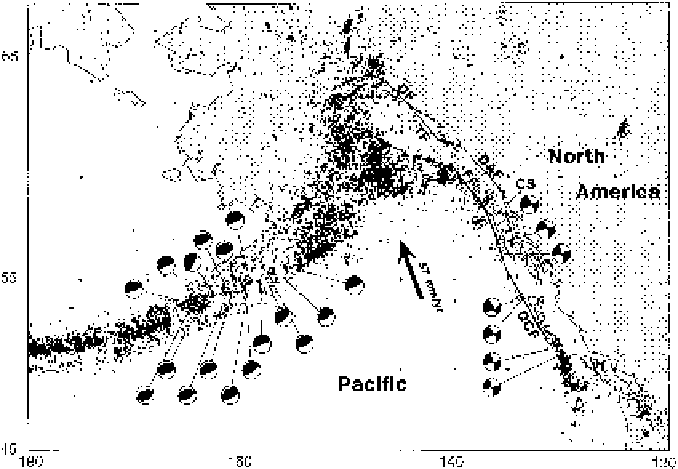Geoscience Reference
In-Depth Information
Figure 9.52.
Focal
mechanism for selected
earthquakes along the
Queen Charlotte Islands
transform fault (QCF) and
along the Alaskan end of
the Aleutian subduction
zone. VI, Vancouver
Island; DF, TF, FF, DAF
and CS, major faults.
Blacks dots, epicentres of
earthquakes shallower
than 50 km. (Courtesy of
C. Demets and R. G.
Gordon.)
A detailed study of the focal mechanisms of large subduction-zone earthquakes
indicates that they are depth-dependent. Earthquakes occurring within the outer
rise of the subducting oceanic plate are predominantly shallow and extensional
with the tension axis perpendicular to the trench. Shallow and medium-depth
earthquakes usually have focal mechanisms with down-dip extension, whereas
deeper earthquakes have down-dip compression. Some subduction zones have no
seismic activity at intermediate depths; this could be due to the slab being bro-
kenorresult from the thermal structure of the slab. The shallow earthquakes
occurring in the overriding plate are predominantly thrust-faulting, whereas
shallow earthquakes in the subducting plate are generally normal-faulting.
Deep earthquakes amount to about 20% of all earthquakes and their mech-
anism has long been enigmatic. There is no major change in apparent focal
mechanism for intermediate and deep earthquakes and yet estimates of the pres-
sure and temperatures indicate that, at these levels in the mantle, the strain should
be released by creep or flow, not fracture. Temperature is an important parameter
in controlling seismic activity at subduction zones. With increasing temperature,
movement on faults will change from stick-slip (earthquakes) to stable sliding to
ductile. Although rupture can be initiated only in the 'stick-slip' region, it can then
propagate below that, but earthquakes below about 300 km are far too deep for
frictional 'stick-slip' to be their cause. Although the bimodal form of the earth-
quake depth distribution suggests that there is a different cause for earthquakes
below about 300 km, the pattern of seismic energy radiated from deep earthquakes
looks very similar to that from shallower earthquakes. The observation that inter-
mediate and deep earthquakes have down-dip compressive focal mechanisms has

